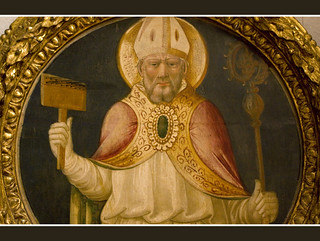
via Medieval Saints yahoo Group:
St. Blaise has achieved perennial popularity in both the East of his origin (hewas bishop of Sebastea in Armenia) and in the West. However, like many anotherfavored saint, we know little about his life.
His (undependable) medieval legend gives the following biography.
Blaise was a boy of high intelligence, so his parents gave him a good Catholiceducation. He went on, then, to the priesthood. While still a young man, hewas chosen bishop of Sebastea, Armenia.
In 316, the Roman Emperor Licinius withdrew from his position of toleratingChristians, and started again to persecute them. Blaise, counseled by God, wentinto hiding in a woodland cave. There his only company was the wild animals;but the gentle bishop soon made friends with them, healed their wounds, andblessed them.
One day, however, some hunters invaded his wilderness in search of wild animalsthat could be used in the stadiums to fight gladiators and devour Christians. They were surprised to find the bishop, and, of course, him and brought him backfor trial. On the trip, says the legend, the party came upon a poor woman whosepig had been carried off by a wolf. Bishop Blaise commanded the robbing animalto return the pig, and so he did, safe and sound. On arrival at the court, thefuture martyr was imprisoned in a dark jail without food to eat or light to seeby. Out of gratitude, the woman whose pig he had restored managed to get himfood and provide him with candles. Another woman brought to the saint herlittle boy, who had caught a fishbone in his throat and was on the point ofstrangulation. Blaise miraculously got rid of the bone.
But Governor Agricolaus treated this merciful unmercifully. Before imprisoninghim, he had him scourged. In due time Emperor Licinius himself arrived, triedto “convert” the bishop to paganism by tearing his body with iron wool-combs,and finally sentencing him to beheading.
Blaise’s subsequent popularity stemmed particularly from his repute as a miracleworker. Three classes of devotees arose: those associated with wild animals;professional wool-combers (with whose tools he had been tortured); and peoplewho wanted to heal or avoid a throat illness. In Germany, St. Blaise came to behonored as one of the cluster of “handy” saints called the “Fourteen HolyHelpers”.
St. Blase has been extremely popular for centuries in both the Eastern and Western Churches and many cures were attributed to him, notably that of a child who was suffocating through a fish bone being caught in his throat. In 1222 the Council of Oxford prohibited servile labour in England on his feast. He is one of the Fourteen Holy Helpers. He is invoked for all throat afflictions, and on his feast two candles are blessed with a prayer that God will free from all such afflictions and every ill all those who receive this blessing. —The Church’s Year of Grace, Pius Parsch
It is customary in many places to bless the throats of the faithful with two candles tied together with a red ribbon to form a cross. The rite of the blessing of throats may take place before or after Mass.
The priest or deacon places the candles around the throat of whoever seeks the blessing, using the formula: “Through the intercession of St. Blaise, bishop and martyr, may God deliver you free from every disease of the throat, and from every other disease. In the name of the Father and of the Son, + and of the Holy Spirit. R. Amen.” — Ceremonies of the Liturgical Year

St. Blaise by Father Lawrence Lew OP via Flickr, licensed cc
Patronage: against wild beasts, animals, builders, carvers,
construction workers, coughs, Dalmatia, Dubrovnik, goiters, healthy
throats, stonecutters, throat diseases, veterinarians, whooping cough,
wool-combers, wool weavers; Guilds of Wool workers;
